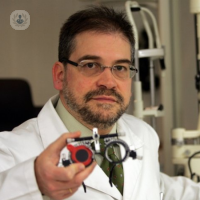Strabismus, a condition that affects large and small
Written by:
What is strabismus?
 Strabismus is a visual problem characterized in that the eyes are not aligned properly. One eye may look straight ahead, while the other is diverted, in, out, up or down. Can be continuous, all the time when one eye is deviated, or intermittent, when the eye is occasionally deviates. You can also always occur in the same eye or alternating, sometimes the right eye and the left deviates other; both can never be diverted at the same time.
Strabismus is a visual problem characterized in that the eyes are not aligned properly. One eye may look straight ahead, while the other is diverted, in, out, up or down. Can be continuous, all the time when one eye is deviated, or intermittent, when the eye is occasionally deviates. You can also always occur in the same eye or alternating, sometimes the right eye and the left deviates other; both can never be diverted at the same time.
The frequency of strabismus in children is 4% in Spain. Strabismus is a problem not only for children, is also present in adults, either because not resolved in childhood or because he has subsequently appeared.
What are the causes?
There are six muscles in each eye that move it in any direction, to align and focus both eyes on a single target. To do this all the muscles of the eye must be balanced and working together. In order that the eyes move together, the muscles in both eyes must be coordinated. The brain is the one that controls the muscles.
The most common are the onset strabismus in children, and most of these are due to the imbalance caused in the development of eye movement for the visual approach. Therefore, defects refractive myopia and hyperopia can favor strabismus.
But there are also other causes strabismus in both childhood and adulthood. These are:
- Paralysis of the nerves that contract these muscles. The origin of the paralysis may be due to trauma, brain tumor or stroke.
- Presence of eye problems that cause loss of vision in one eye, such as a cataract; then the eye loses visual reference and therefore can get sidetracked.
Do you have a disorder associated?
Strabismus is the most common cause of amblyopia, or what is the same, "lazy eye". When a child's eyes are not aligned properly, the brain just by looking and avoid eye stimulation is crooked eye is stimulated. The result is the lack of development of vision in that eye if strabismus, unless occlusive treatment is performed through the eye patch on the eye that is right is not corrected.
Thus strabismus, a problem that may seem only aesthetic, is an important aspect as it is the alteration of vision development in childhood, becoming the most common cause of amblyopia.
Why reason may develop in the adult?
One of the reasons already mentioned that cause strabismus is paralysis of the muscles that move the eyes. The origin of this paralysis is varied: traumatic brain injury, stroke, brain tumor, orbital injury, among others.
Sometimes it happens that, since childhood, there is a tendency to squint that can occasionally or never manifest, but from 40 or 50 years left to realize the control of that trend and strabismus constantly manifests.
Moreover, eye injuries that generate visual loss, strabismus can cause losing visual reference, that was what kept the right eyes.
How you can treat strabismus?
Basically, strabismus can be treated in Ophthalmology in two ways, by surgery or glasses.
There convergent strabismus in childhood, an eye inward, disappearing with the total correction of hyperopia through glasses. This type is called accommodative convergent strabismus. Wearing glasses can correct strabismus and make it disappear in the adult.
If not before, and strabismus aesthetically note, the solution is surgery on it or the corresponding eye muscles or eyes. Eye muscles are detached from the wall of the eye and repositioned during surgery, depending on the direction of rotation of the eye may be required to perform an operation in one or both eyes. This procedure is performed under general anesthesia in children and may be under local anesthesia in adults. Recovery is rapid. Both children and adults often easily resume their normal activities within a few days.
There is a third possibility strabismus, which is the injection of botulinum toxin on the muscles we want to paralyze and compensate strabismus. The limitation of this technique is that it produces paralysis during months. The toxin can be used alone or as an adjunct to surgery.
In children, both the treatment of strabismus as amblyopia must go together, because of the interrelatedness of both problems.
Edited by Roser Berner Ubasos.


